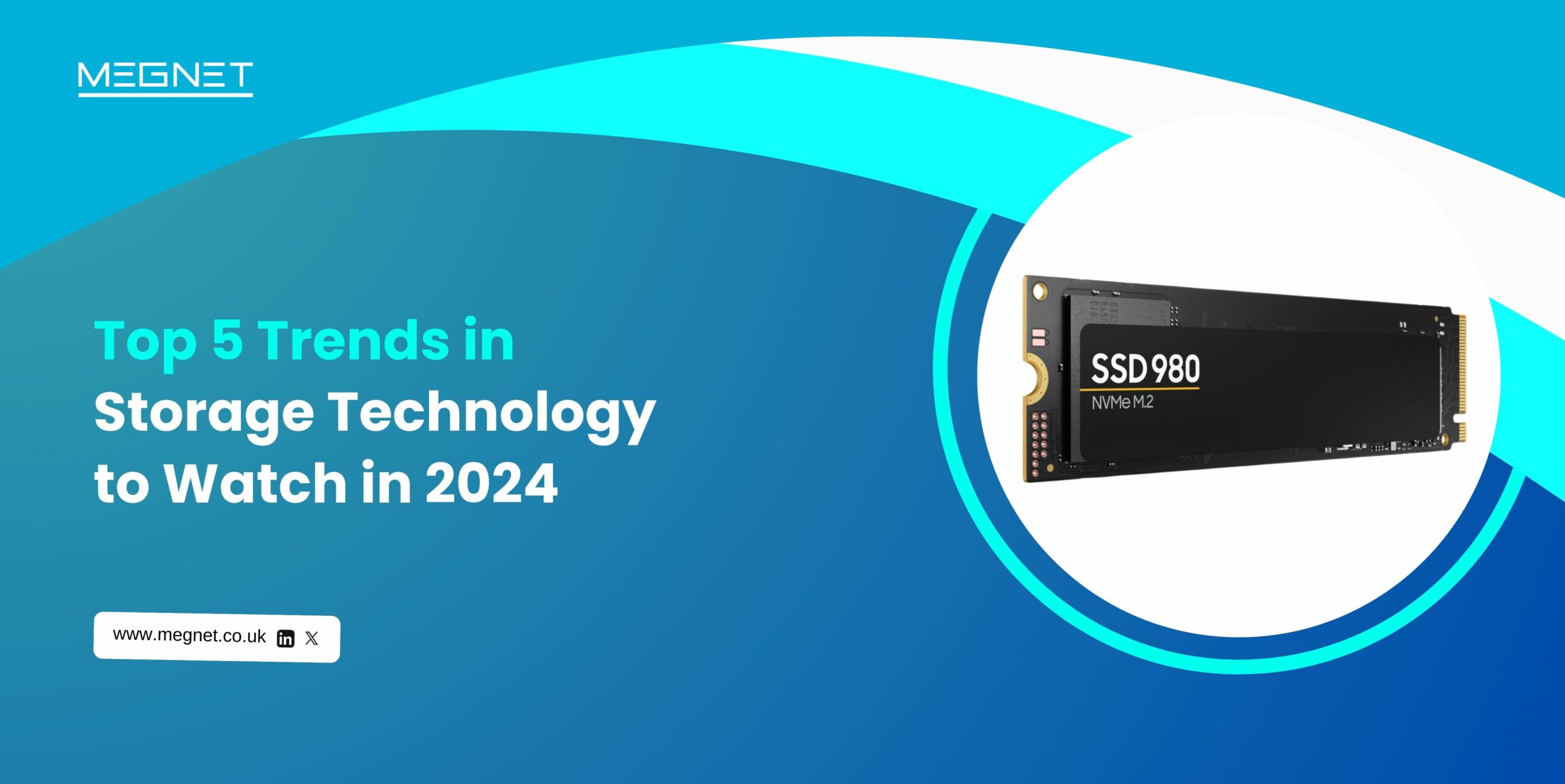2024 Storage Technology Trends: What You Need to Know
The storage industry is evolving at a breakneck pace, driven by the demands of data-intensive applications, cloud computing, artificial intelligence, and edge computing. As organizations seek to enhance their IT infrastructures, staying updated on the latest trends in storage technology is vital for gaining a competitive edge. In this blog, we delve into the top 5 trends shaping the storage landscape in 2024 and explore their impact on businesses worldwide.
- The Rise of NVMe-over-Fabrics (NVMe-oF)
Primary Keyword: Storage
The non-volatile memory express (NVMe) protocol has revolutionized storage by offering unparalleled speed and efficiency. In 2024, the adoption of NVMe-over-Fabrics (NVMe-oF) is set to expand, bridging the gap between high-performance storage and scalability. This trend is being driven by the need for low-latency and high-throughput solutions in data centres.
Why It Matters
- NVMe-oF leverages network protocols like Fibre Channel, RDMA, and TCP/IP to extend NVMe’s capabilities across fabrics.
- Enables data centres to support demanding workloads, such as AI/ML and real-time analytics.
- Offers seamless scalability while maintaining the speed and efficiency of direct-attached storage (DAS).
Key Use Cases
- Hyperscale data centres
- High-performance computing (HPC) environments
- Real-time financial transactions
Actionable Insight:
For businesses exploring storage upgrades, transitioning to NVMe-oF can future-proof IT infrastructures, ensuring they can meet performance requirements for years to come.
- Growth of Object Storage in Multi-Cloud Environments
Primary Keyword: Storage
Object storage has become indispensable in handling unstructured data. In 2024, its adoption in multi-cloud environments is expected to surge, owing to its scalability, cost-efficiency, and ability to seamlessly integrate across platforms.
What’s Driving the Trend?
- The proliferation of unstructured data from IoT devices, social media, and video streaming.
- Increased focus on cost optimization in cloud storage.
- Interoperability features that allow businesses to avoid vendor lock-in.
Advantages of Object Storage:
- Highly scalable for petabyte-scale datasets.
- Integrates seamlessly with data lakes for analytics and AI workloads.
- Supports metadata tagging, enabling smarter data management.
Popular Use Cases:
- Media and entertainment industries for video archiving.
- Healthcare for storing medical imaging data.
- E-commerce for catalogue and transaction data storage.
- Expansion of AI-Driven Storage Solutions
Primary Keyword: Storage
AI-driven storage is no longer a futuristic concept; it’s a reality reshaping the way organizations manage their data. In 2024, the trend toward AI-integrated storage systems will gain significant momentum, offering smarter and more automated data management solutions.
Capabilities of AI in Storage:
- Predictive analytics for storage demand forecasting.
- Automated tiering to optimize storage costs.
- Enhanced data security through anomaly detection.
Why It’s a Game-Changer:
AI-driven storage solutions enable businesses to extract actionable insights from stored data more efficiently, reducing time-to-value.
Real-World Applications:
- Retail: Personalizing customer experiences using real-time data analytics.
- Healthcare: Accelerating research by analysing vast genomic datasets.
- Manufacturing: Optimizing supply chains with predictive analytics.
- Edge Storage Grows with IoT Proliferation
Primary Keyword: Storage
Edge computing is transforming industries by processing data closer to its source. In 2024, edge storage will become increasingly critical as the number of IoT devices grows exponentially.
Key Features of Edge Storage:
- Low latency and high-speed data processing at the edge.
- Robust solutions to handle intermittent connectivity.
- Compact and durable designs tailored for harsh environments.
Industries Benefiting from Edge Storage:
- Smart cities: Managing traffic data and surveillance footage locally.
- Manufacturing: Enabling real-time equipment monitoring.
- Agriculture: Supporting precision farming with IoT data analytics.
Challenges and Solutions:
- Data Security: Using end-to-end encryption and zero-trust architectures.
- Scalability: Deploying modular edge storage solutions for flexible expansion.
- Focus on Energy-Efficient Storage Technologies
Primary Keyword: Storage
As sustainability becomes a critical focus for organizations worldwide, energy-efficient storage technologies will dominate in 2024. Enterprises are seeking solutions that not only reduce operational costs but also align with environmental goals.
Technologies to Watch:
- Solid-State Drives (SSDs): Consuming significantly less power than traditional HDDs.
- Cold Storage: Optimizing archival storage to reduce active power use.
- Liquid Cooling in Data Centres: Improving energy efficiency by addressing heat dissipation challenges.
Sustainability in Action:
- Hyperscalers like Google and Amazon are investing heavily in green storage solutions.
- Regulations are encouraging businesses to adopt more sustainable IT practices.
How Businesses Can Adapt:
- Audit current storage energy consumption.
- Invest in green storage technologies with measurable ROI.
- Leverage AI-driven tools to minimize energy usage in storage systems.
How Megnet Can Help
As a leading distributor of OEM storage solutions, Megnet offers cutting-edge products tailored to meet the demands of modern businesses. Whether you’re looking to upgrade your storage infrastructure to NVMe-oF, adopt energy-efficient solutions, or explore AI-driven storage, our team is here to assist.
While the top five trends provide a comprehensive overview, there are additional developments in storage technology that deserve attention. Let’s delve into some bonus trends that will also impact the industry in 2024.
Data-Centric Security Solutions
With cyber threats growing in complexity, storage solutions must prioritize data security. In 2024, data-centric security will play a pivotal role in ensuring that sensitive information remains protected.
Key Features of Data-Centric Security:
- End-to-end encryption for data at rest and in transit.
- Tokenization to reduce exposure of critical data.
- Role-based access controls to ensure only authorized personnel can access specific data.
Trends Driving Adoption:
- The rising threat of ransomware attacks.
- Compliance with stringent data protection regulations, such as GDPR and CCPA.
- Growth in hybrid work environments necessitating secure remote access to storage systems.
Actionable Insight:
Organizations should integrate security features directly into their storage solutions rather than relying solely on external tools. Partnering with vendors offering robust security capabilities is essential.
Advancements in Storage Virtualization
As businesses strive to optimize their IT operations, storage virtualization is becoming a cornerstone of modern infrastructures. By decoupling physical storage from applications, virtualization enables greater flexibility and efficiency.
Benefits of Storage Virtualization:
- Simplified management of diverse storage systems.
- Improved utilization of storage resources, reducing waste.
- Enhanced disaster recovery capabilities through automated failover systems.
Future Developments in 2024:
- Integration with containerized environments, such as Kubernetes.
- AI-driven orchestration for smarter workload allocation.
- Increased adoption of Software-Defined Storage (SDS) platforms for scalability.
Pro Tip:
Evaluate your storage environment to identify inefficiencies that can be addressed with virtualization. Tools like VMware vSAN and Microsoft Storage Spaces Direct can simplify implementation.
Hyper-Converged Infrastructure (HCI) Expands Its Footprint
Hyper-converged infrastructure combines compute, storage, and networking into a single system, offering simplicity and scalability. In 2024, HCI adoption will grow, particularly among small and medium-sized businesses seeking cost-effective solutions.
Why HCI is Gaining Popularity:
- Reduces data centre complexity by consolidating resources.
- Provides a scalable architecture to accommodate growth.
- Offers integrated backup and disaster recovery capabilities.
Emerging Trends in HCI:
- Use of AI to optimize resource allocation dynamically.
- Enhanced support for edge computing applications.
- Expansion into hybrid cloud environments for seamless workload migration.
Industries Benefiting Most:
- Healthcare for managing electronic medical records (EMRs).
- Retail for processing point-of-sale (POS) data in real-time.
- Financial services for ensuring compliance and data security.
Emergence of Quantum Storage
While still in its infancy, quantum storage is making waves as a potential game-changer for the industry. This technology promises to revolutionize data storage with unprecedented speed and capacity by leveraging quantum mechanics.
What to Expect in 2024:
- Continued research into stable quantum storage mediums.
- Early adoption in fields like cryptography and scientific research.
- Collaboration between tech giants and academic institutions to accelerate development.
Why It’s Exciting:
Quantum storage could potentially store petabytes of data in a fraction of the space required today. While practical applications are years away, the groundwork being laid now will shape the future.
Storage as a Service (STaaS) Becomes Mainstream
The shift from capital expenditure (CapEx) to operational expenditure (OpEx) models is driving the popularity of Storage as a Service (STaaS). In 2024, businesses of all sizes are expected to embrace this pay-as-you-go model for its cost-efficiency and flexibility.
Features of STaaS:
- Scalability: Add or reduce storage capacity as needed.
- Managed services: Offload storage management to the service provider.
- Predictable pricing: Pay based on usage, avoiding over-provisioning.
Top Providers to Watch:
- AWS S3 for scalable object storage.
- Microsoft Azure Storage for hybrid cloud integration.
- Google Cloud Storage for high-performance workloads.
Adoption Challenges:
- Concerns over data sovereignty and compliance.
- Dependency on network performance for access to cloud storage.
Best Practice:
Conduct a cost-benefit analysis before transitioning to STaaS. Ensure your provider offers robust SLAs and compliance support.
Explore the latest trends and find the right storage solutions for your business. Contact Megnet today for a personalized consultation and take the first step toward transforming your storage strategy.
The storage industry is at the cusp of transformative changes, driven by emerging technologies and evolving business demands. From NVMe-over-Fabrics to energy-efficient storage, the trends highlighted in this blog are shaping the future of IT infrastructures. By staying ahead of these developments, businesses can ensure they remain competitive in an increasingly data-driven world.
Explore these storage trends and more with Megnet—your trusted partner in cutting-edge networking and storage solutions. Get in touch with us today and discover how we can help transform your storage strategy.
FAQ's
NVMe-over-Fabrics (NVMe-oF) extends NVMe’s high-speed capabilities over network fabrics, enhancing storage performance in large-scale environments by providing low-latency and high-throughput data access, ideal for data centers and high-performance computing (HPC) systems.
Object storage stores data as objects rather than files in a hierarchical structure. It is more scalable and cost-efficient for handling large volumes of unstructured data, making it ideal for cloud environments and backup solutions.
AI-driven storage management uses machine learning to predict storage demand, automate data tiering, and optimize storage allocation. It enhances efficiency, reduces costs, and helps businesses handle increasing data workloads with minimal manual intervention.
Edge storage allows data generated by IoT devices to be processed locally, reducing latency and bandwidth requirements. It ensures faster decision-making and is essential for real-time data analytics in industries like manufacturing and healthcare.
Energy-efficient storage technologies, such as SSDs and cold storage, reduce power consumption and operational costs. They also align with sustainability goals, helping businesses lower their carbon footprint while managing large amounts of data.
Storage virtualization abstracts physical storage resources, enabling centralized management and flexibility. It allows for better resource allocation, simplifies scaling, and integrates multiple storage systems, unlike traditional methods that rely on physical hardware management.
Businesses can enhance cloud storage security through encryption, access controls, and regular security audits. Implementing multi-factor authentication (MFA) and ensuring compliance with industry regulations are also crucial to protecting sensitive data.
Hyper-converged infrastructure (HCI) integrates storage, compute, and networking into a single platform. It simplifies deployment, reduces hardware requirements, and enhances scalability, making it an ideal solution for small and medium-sized businesses
Cold storage is used for long-term data retention at a lower cost by storing infrequently accessed data in energy-efficient systems. It’s perfect for backup, disaster recovery, and compliance requirements where rapid retrieval isn’t a priority
Quantum storage has the potential to revolutionize data storage by utilizing quantum mechanics for faster, denser, and more secure data storage. While still in early development, it promises to handle vast amounts of data with unprecedented speed and efficiency in the future.









Leave a comment
Your email address will not be published. Required fields are marked *